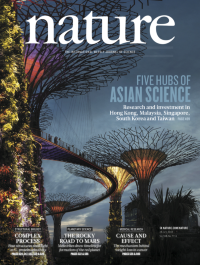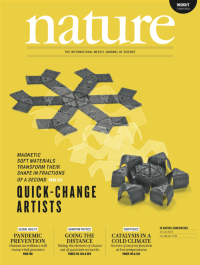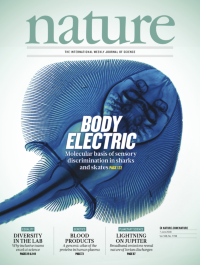Volume 558
-
No. 7711 28 June 2018
Five hubs of Asian scienceThe cover shows the Supertree Grove in Singapore, one of five key research hubs in Asia profiled in a special issue this week. Along with Hong Kong, Malaysia, South Korea and Taiwan, Singapore is investing in science and increasing its global reach as a result. Scientists from across these five centres provide an insight into the breadth of dynamic work being done — from genome editing to green-energy development — and the way the changing research landscape is attracting skills to the region. They also reveal how a focus on science is helping to address public concerns such as health care and air pollution. These five hubs might not be heaviest hitters in the continent, but they are rapidly becoming a major force in the global scientific landscape.
Nature Index
-
No. 7710 21 June 2018
In deep waterThe growth of tropical coral reefs is essential for maintaining reef structure and habitat diversity, and for protecting many shorelines from wave exposure and flooding risks. But, as Chris Perry and his colleagues reveal in this week’s issue, these important functions are under threat as reef health declines and sea levels rise. Declining growth means that reef structures are being diminished, and as water levels rise, the depth of water above the reefs increases. This means that the reef needs to grow vertically to offset the change. In their analysis of reef growth rates in the tropical western Atlantic and Indian Ocean, the researchers found that although the reefs are just about keeping pace at present, changes in reef ecology mean that few reefs in either region will be able to keep up under the moderate or severe sea-level-rise scenarios projected for climate change. As a result, the team suggests that low-lying coastlines and small island nations may lose a key contributor to their coastal protection.
-
No. 7709 14 June 2018
Quick-change artistsSoft materials that can switch between 3D shapes in response to a range of stimuli have possible uses in areas such as robotics, electronics and biomedicine. But such transformations can be slow, with the shape changes sometimes taking minutes to complete. In this week’s issue, Xuanhe Zhao and his colleagues present a technique for creating soft materials that undergo rapid, reversible transformations in fractions of a second under the influence of a magnetic field. The researchers use 3D printing to embed and align ferromagnetic neodymium–iron–boron microparticles within a silicone rubber matrix. By controlling the alignment of the particles during printing, they can program specific shape changes in different regions of the printed objects, creating materials that can perform a range of movements such as rolling, jumping and grasping objects.
Insight
-
No. 7708 7 June 2018
Body electricSkates and sharks have specialized electrosensory organs that detect weak electric fields and communicate the information to their central nervous systems. In this issue, David Julius and his colleagues analyse sensory cells within these organs and show that although both skates and sharks use similar low-threshold voltage-gated calcium channels to start the cellular process, they each use distinct potassium channels to modulate this activity. The authors found that the potassium channels in the chain catshark (Scyliorhinus retifer) support large, repetitive membrane voltage spiking in response to electrical stimuli, but those in the little skate (Leucoraja erinacea, pictured on the cover) produce smaller, tunable oscillations. The researchers suggest that as a result sharks use their electrosensory capabilities primarily as an aid in predation whereas skates also use them to communicate with one another.




